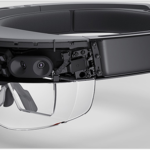The Robots Among Us

Humans have long envisioned mechanical servants; references can be found as far back as the fourth century BC, and appear in the writings of ancient Chinese, Muslims, and Leonardo da Vinci, who designed a mechanical knight who could sit up, wave its arms, and move its head and jaw. In the 1700s, automatons, or mechanical humans, could act, draw, fly, or play music (History of Robots, 2017). Like these automatons, robots in popular culture tend to take on human characteristics. Visitors to the 1939 New…
Enhanced Humans Part 1

Writers have envisioned machine-human hybrids for nearly 200 years. As early as 1839, Edgar Alan Poe’s “The Man That Was Used Up” told a satirical story of a war hero injured so severely that he consisted mainly of prostheses. If you’re older than a certain age you may remember watching “The Six Million Dollar Man” on Friday nights or seeing RoboCop in the 1980s or Iron Man more recently. It probably seemed very futuristic. But another way to look at cyborgs is to consider fictional characters such as the…
Technology and Privacy: Evolving Legal Issues

Technology is changing the nature of privacy. We are increasingly asked to allow access to personal information in exchange for a service, for increased convenience, or simply in exchange something that is cutting edge or seems cool. Many are willing to make this exchange, but are we really aware of the ramifications of this decision? Content Scanning Google released Gmail in 2004 as a “free” email service, but they were not being altruistic. In exchange for providing a free, convenient, and easily accessible e-mail service,…
Virtual Reality: The Next Patent Battleground – Part 2

This is the second in a series of articles looking at intellectual property, liability, and privacy issues in virtual and augmented reality. You may want to read Part 1 if you haven’t done so already. Intellectual Property in the Real World According to an analysis conducted in 2014 of publicly available data provided by the U.S.P.T.O. (Greenbaum, 2014a), virtual reality patents began to appear in 1992. Since many virtual reality (VR) patents are more than 10 years old, some may be unenforceable due to unpaid maintenance…
Virtual Reality: The Next Patent Battleground – Part 1

I recently read of an interesting property dispute: Sailor’s Cove is a relaxing waterfront community… with cobblestone streets and New England–style homes bordering the dock. Quaint boutiques line the rocky coast, as [residents] spend their days watching sailing events, yachting, or perusing the local bookshop. Sailor’s Cove is comprised of 21 private islands developed by Isabella Bentham, Tasha Kostolany, and Patrick Leavitt… In 2008 a dispute erupted between Leavitt and the other two “developers” when he attempted to assert ownership over the community and its…
Virtual Reality: The Potential and the Challenges

Imagine being in a movie – not watching a movie, but wandering around inside the movie, looking at and listening to what you want. That’s the potential of virtual reality, and it’s getting close. In this article, I’ll look at where virtual reality may take us in the next few years, and I’ll also discuss some of the challenges to this vision. If you want to learn more about virtual and augmented reality (VR and AR), you can read my two previous articles, covering the…
Virtual and Augmented Reality Today – Part 2

In an earlier article I shared my enthusiasm for virtual and augmented reality (VR and AR). I believe these technologies offer tremendous potential, and they are particularly exciting to me as a user interface designer, as they allow new ways to interact with the digital and physical world around. In the previous article, I introduced the technologies that enable modern VR and AR hardware. Now let’s take a look at some examples ofvirtual and augmented reality implementations that show these technologies at work. Specialized Applications…
Advances in Virtual Reality – Part 1

Did you have a View-Master when you were young? Do you want to try an Oculus Rift or HTC Vive headset? These virtual reality devices show how far the technology has come. We haven’t reached the promise of a fully immersive world, as conveyed in movies such as Tron, Lawnmower Man, The Matrix, and Inception, and of course Star Trek’s holodeck, but we are getting closer. Many believe that virtual reality is on the verge of a popular breakthrough. As a human factors engineer, I…
Self-Driving Cars: Liability and Ethical Issues

You’re driving on a mountain road, alone in your car. On one side there is a sheer rock wall, on the other a steep drop off. Two pedestrians step out in front of you. You cannot stop in time. The only way to avoid them is to swerve and plunge over the drop off. What do you do? This unfortunate scenario is highly unlikely, and not something that we worry about in day-to-day life. It is, however, the type of scenario that designers of self-driving…
Self-Driving Cars: Driver Attention

In a previous article, I talked about the exciting potential of self-driving cars and expressed my concerns that we’re entering a dangerous transition period as self-driving technologies are becoming available to consumers more rapidly than we can safely use them. In this article, I’d like to discuss these concerns in more detail. The National Highway Traffic Safety Board (2013) has identified five levels of vehicle automation: Level 0: No Automation – The driver is in complete control. Level 1: Function-Specific Automation – Selected functions are…
Self Driving Cars – The Promise and the Risk

Most of us have heard of Google self-driving cars. Since 2009, their fleet of custom vehicles has put in more than one million self-driven miles. Although few of us have ever seen one of these vehicles, the same technology has been slowly making itsway into the vehicles we are buying and driving today. I believe that that we are reaching a turning point, wherethis increasingly sophisticated technology, which offers immense promise in the long run, is becoming available to consumers more rapidly than we can…
Simplifying Complexity – Part 1

“Why did they have to make this so complicated?” We’ve all said or thought this as we sat in front of a computer screen, struggling to perform a task but unable to figure out how to do it. Frustrated, we wish the software could be made simpler to better accomplish the task at hand. Modern software can be complex, and Part 1 of this series will take a look at some of the forces that drive complexity and thwart simplicity, and why complexity cannot be…
Simplifying Complexity – Part 2

Cognitive Load and Mental Models In Simplifying Complexity – Part 1, we looked at the lure of simple software and the reality that software is complex, and often for good reasons. In Part 2 of this series, we will begin our look at some of the techniques that user interface designers can use to deal with complexity. We’ll start by looking at the big picture, at some high-level design approaches. Then, in Parts 3 and 4 we will turn to some specific design techniques. Your…
Using Visual Simplicity in User Interface Design

This article will look at visual simplicity. Visually, the Google search page, the portal for many to the web, is about as simple as a user interface gets. Compare the Google’s UI to Craiglist. The obvious difference is that the Craigslist UI is visually busier, more cluttered, more complicated. This is somewhat ironic, because vast complexity resides behind Google’s search box. Google predicts your typing, interprets your query, and using information gathered by its web crawlers, processed by its indexer, and filtered for spam, serves…
Why Follow User Interface Standards?

Someone recently asked me about the credibility of user interface standards, which provide requirements or guidance for web sites, software, or hardware, with the objective of making an interface “more intuitive, learnable, and consistent.” How valuable are standards? What are they based on, and what makes one standard better than another? Is it worth the effort to learn the standards, and which standards are best for me or my organization? There are a wealth of user interface standards available. Books and articles provide much guidance…
Implementing User Interface Standards

The previous article in this series discussed the importance of user interface standards and why you might want to a standard for your user interface or design work. This article will look at some standards and guidelines. As you consider them, keep in mind that a standard might not be ideally suited to your needs. You may need to revise or supplement it. How do you decide which standard is best for you or your organization? It’s beyond the scope of this article to compare…
Simplifying Complexity through Organization

Organizational Simplicity The previous article in this series introduced mental models. A mental model is a framework, or a basic structure, that users can take from one situation and apply to another. For example, the concept of an online shopping cart allows users to apply their knowledge of a physical shopping cart to help understand how an online shopping cart works. If we have a good mental model, then the complex becomes simpler by allowing the user to employ their past knowledge and experience when…
Human Factors in Software Development

The first two articles in this series introduced the human factors profession and provided examples of human factors contributions in various industries. This article, Part 3, will focus on one specific industry, software development, and show how human factors engineers participate in the software development process. (Here are links to Part 1 and Part 2, if you want to refer to them.) As you read this article, be aware that there are different software development methodologies. If you know them, you may be familiar with…
Human Factors at Work

The first article in this series introduced human factors specialists and how they study the sensory, cognitive, and motor aspects of human performance. Now we will take a closer look at some of the work that human factors engineers are involved in. Distracted Driving We’re all familiar with the dangers of driving while texting, talking on the phone, checking Facebook, or looking at a navigation app. According to the U.S. Government, 3,154 people were killed in the U.S. in 2013 because of distracted drivers. [1]…
How to Protect Your Valuable User Interface Intellectual Property

A well-designed, attractive user interface is valuable. In fact, it may be one of the most valuable components of your software. Apple built the biggest company in the world on best-in-class design and usability. If you develop software, you should be aware of the value of your user interface (UI), whether you should take steps to protect it, and whether you may be at risk of infringing on another UI. The tools used to protect intellectual property such as user interface–copyrights, trademarks, and patents–are complex.…
What is Human Factors Anyway?

What do these events have in common? In 1986, operators at the Chernobyl Nuclear Power Plant were conducting an experiment that required them to operate the reactor in an unstable power level. Because they were under pressure to complete the experiment, they disabled several safety systems and modified procedures on the spot to enable the reactor to operate in this state. One researcher later reported that they were “mesmerized by [a] mindset to complete the experiment.”[1] We know the result of this experiment: “An explosion…
Why Apple vs. Samsung Mattered

Full disclosure: I was an expert witness for Samsung in this Apple vs. Samsung case. In 2011, Apple sued Samsung in US court for patent infringement over design similarities between the iPhone and various Samsung Android phones. This was the opening shot in a series of legal battles fought in multiple countries over three years, costing the two companies nearly a billion dollars. When the dust settled, Apple was largely the winner, the courts finding that Samsung had copied Apple design features. To the consumer,…

